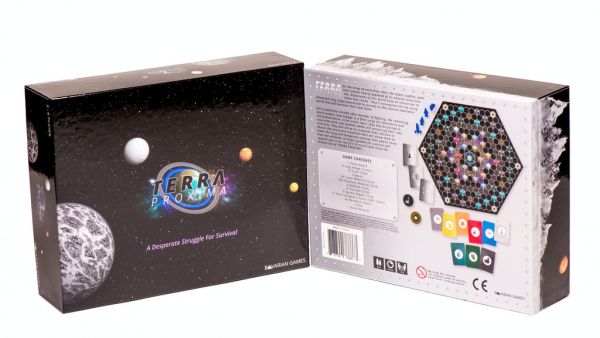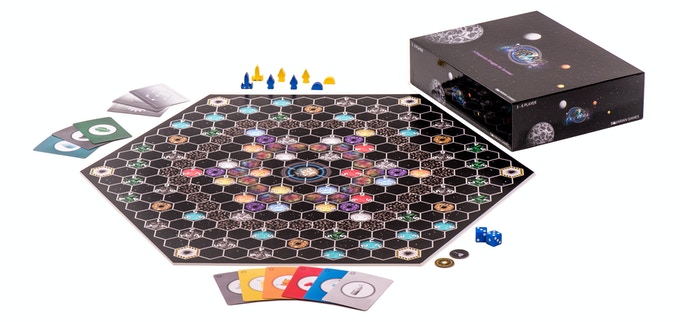Preview: Take Part in Space Exploration, Production, and Battles in Terra Proxima

Collect materials, battle enemy ships, build bases, and wheel and deal in this space game about racing to claim the center planet.
Currently on Kickstarter, Terra Proxima has players choosing carefully which planets to gather resources from, hoping the dice rolls each turn will cause those planets to produce much needed materials which will then be used to fly, build, and attack.
Gameplay
Each player starts the game by choosing one of the launch pads around the edge of the board and placing their long range cruiser on it. Each player is also given a base and two scout ships, which they can build later. Everyone is dealt a system repair card. Each system repair card lists one type of material. You will have to discard four copies of this material at once in order to resolve the system repair. You cannot win the game until you have resolved your card.
You also start the game with one each of the six planetary materials (there are also three different types of lunar materials in the game). You may only ever have eight at one time of either kind, making a hand limit of sixteen. You may never go over your hand limit. During the game, lunar material cards are always kept face up in front of you, while planetary cards are kept secret in your hand.
The board is made up of hexagonal spaces. The center one is Terra Proxima. To win the game you have to be the first to land on Terra Proxima.
Some spaces are empty, while others contain planets, moons, wormholes, asteroids, and nebula. The asteroids and nebula both serve to divide the board into three sections. Players start on the outside section and work their way in during the game.
The first phase of your turn is the production phase. You roll both dice. Any player who has a ship or base on a planet or moon that shows one of the two numbers rolled, takes a material card (the material type depends on the color of the moon or planet). Each player also starts the game with a plus one card, which they can spend to take an extra planetary card.
If you roll doubles on the dice, then you resolve an EMP. If you have less than two EMP tokens, you take a token, you are the only player to produce, and you may take one planetary material card from an opponent or two lunar material cards (or one card from two players). If you have two EMP tokens, then you return them to the deck, all other players produce and you do not, and you must discard two planetary material cards from your hand.
Next you move onto the action phase. There are four actions you can take, in any order, on your turn: move, trade, build, and attack. You can build a base, a scout ship, or a research token. Bases are free to build, the others all require you to discard certain material cards to complete. You must have a ship on a moon or planet in order to build a base or scout ship, which you then place on that space. Bases never move once placed, but you can use move actions on the scout ships. You need one research token before you can move through the asteroids, and three before you can move through the nebula. Finally, you need seven in order to land on Terra Proxima.
For trading, you may trade material cards freely with other players, or trade with the bank following set rates. You may also discard material cards if you simply do not want them in your hand.
To move, you must either discard a planetary card, two matching lunar cards, or one of each lunar card type. You may then move all your ships up to three spaces. If you take a second move action, you may only move one ship three spaces, however you can now send it through a wormhole, which allows you to move between matching wormhole spaces on the board. If you win an attack on your turn, you are allowed to pay for a third movement action, which also allows a single ship to move three spaces.
You announce which ship you are attacking and then both players roll a die, and the highest roll wins. Before the attacker rolls, one other player can offer to give support, in which case he places down one planetary card or two lunar cards on the table. This will add plus one to the attack roll. If the defending player has more research tokens than the attacker, he gets plus one to his roll (or plus two if he has two or more tokens than his opponent). Finally, each player starts the game with a defense card, which you can spend in order to add three to your defense roll.
If the attacker wins, he takes two planetary cards or four lunar cards from the bank, while the defender discards one planet card or two lunar cards. If the target was a ship, it is also moved onto empty space. If a player gave the attacker support, he receives one planetary card or two lunar cards from the bank and gets back the cards he played for the support.
If the defender wins, the attacker loses one planetary card or two matching lunar cards and the attacking ship cannot move for the rest of the turn. If a player gave support to the attack, he discards the cards that he played. Finally, if the defender used his defense card, then he gets to take one planetary card or two matching lunar cards from the bank.

Review
Terra Proxima does a good job of giving you the sense of journeying through space, as you work to collect the materials, build more ships, and make it through first the asteroids and then the nebula. Each new benchmark that you meet feels satisfying.
There are lots of choices open to you on your turn, and we liked how many actions you have to choose from as well as the freedom to decide what order you want to take them in. The attacking mechanism is interesting in the way it is as much about trying to set an opponent back as it about collecting more resources. It is also very much a push-your-luck mechanism, as you cannot ever guarantee victory, even when another player gives you their support.
From the trading to the support mechanism and attacking, there is a nice amount of player interaction, especially as no two players can build on the same planet or occupy the same space (although you can move through an opponent’s space). This gives you some fun ways to block each other or directly compete for certain resources.
Movement around the board is interesting as well, as you build research tokens to move on to the next sector or use wormholes to move closer to the planets you need while only being able to use those wormholes if you’ve performed the move action twice. The fact that every action you take has a cost, ensures that each material card you collect is valuable regardless of whether or not it’s exactly the one you were hoping for.
There are a lot of little details to remember in the rules, however — things like the exact conversion rates for trading with the bank, the costs for building, and the number of research tokens you need. The game would certainly benefit from player aids or an easy to access reference sheet, and while the gameplay is not too complex in itself, teaching the game will take some time.
Terra Proxima has plenty of strategy to offer, and the race to reach the center of the board while needing to meet certain requirements first, works well both thematically and mechanically. There is a nice escalation built into the game, as you build more ships to collect more resources faster, and circle in on the winning planet. If you enjoy space games, check out Terra Proxima on Kickstarter.
Pros: Lots of choices on your turn, plenty of player interaction
Cons: Takes a little while to teach, could use player aids or reference sheet
UPDATE: The publisher has expressed their intent to include a reference sheet in the final version of this game
Disclosure: this preview is based on our evaluation of a digital prototype of the game. While a modest payment was received to expedite the review process, our thoughts and opinions expressed here are honest and accurate.




